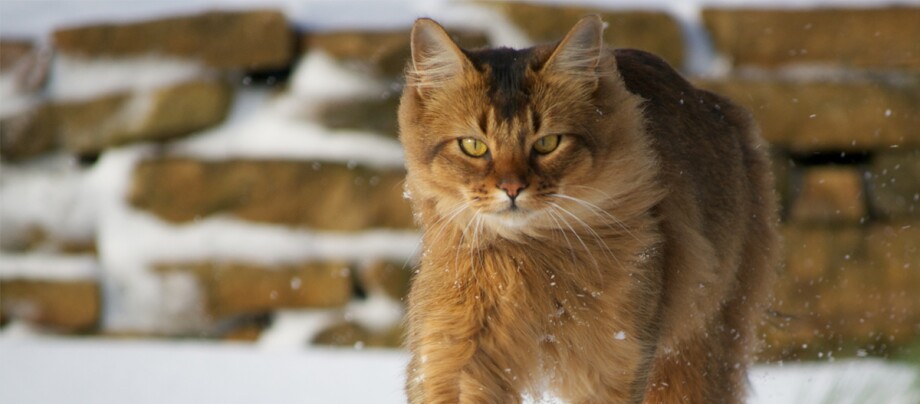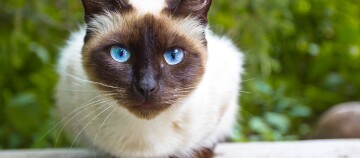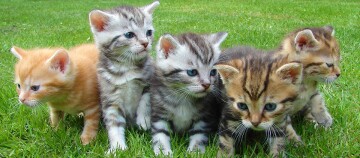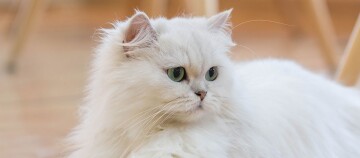Somali Cat - A Sporty “Oriental” with Lots of Self-Confidence
01.01.2024 - Reading time: 3 minutes

When you see a Somali cat with its silky coat, you might expect it to spend the day sitting on velvet cushions and being courted by its human. Wrong: Somali cats are real action athletes who love to romp, climb and play. Due to this high urge to move, Somalis need above all a lot of space and activity. Unlike in English-speaking countries, the aesthetic cat with the engaging, lively nature is still a relatively exotic phenomenon in this country.
NewsletterSomali Cat
Breed | Somali |
Origin | USA |
Size | medium in size, 28 to 36 centimetres (head-torso length) |
Weight | 4 to 5 kilograms (male), 3 to 4 kilograms (female) |
Physique | medium length, supple, firm, high legged |
head shape | wedge-shaped, large ears |
Eyes | large and almond-shaped, yellow, amber or green
|
Coat and colour | half-length or long, “wild-coloured”, cream, blue-grey, cinnamon; “ticked” |
Coat care | simple, daily brushing |
Nature | intelligent, curious, spirited, dominant |
Special features | Variant of the Abyssinian cat with longer coat |
Owning | Free-range and multi-cat keeping recommended |
Somali cat: Nature
If you do not mind being shadowed at every turn, the Somali is an ideal housemate. These intelligent and very knowledgeable animals always want to be part of the action – nothing escapes them. Somalis feel uncomfortable as a solo cat. There should be a companion in the house for cuddling and roughhousing, although the Somali can show dominant tendencies. Littermates as a cat team of equals are therefore ideal. Despite her affection, the Somali is not a lap cat. She is quite cuddly towards her humans, but reacts just as jealously if she sees her position in the household in danger. Somalis can be trained, have a quick perception and a relatively high stress tolerance by cat standards.
Keeping and care of the Somali cat
Somalis are active and clever cats who need physical and mental activity. An extra robust scratching post and turbulent play sessions are just as important as stimulating intelligence toys. Since the cats have an extremely high urge to move, they are not suitable for purely indoor living. Rather, they should have the opportunity to exercise outdoors in a safe environment. The Somali is not suitable for a household where it is left alone for long periods during the day. Smaller pets such as pet birds or aquarium fish should not be left unattended in the same room with the Somali cat. A peaceful coexistence with a dog, however, is possible with careful acclimatisation.
The care of the semi-long silky cat coat is unproblematic. Daily brushing and checking for parasites that the cat might catch when going outdoors are sufficient.
Somalis have a higher predisposition to metabolic diseases and a retinal disease that can lead to blindness. When purchasing a Somali kitten, check with the breeder that none of the parents have a history of disease.
Somali cat colours
Somalis come in four recognised coat colours, whereby the “ticking” – a banding of the individual hairs, each with a dark tip – characterises the colour impression: cream (fawn), blue-grey (steel-coloured ticking), aguti-coloured (apricot with black ticking, appears brown overall) and cinnamon (reddish hair with black ticking). Colour variations such as lilac or chocolate occur, but do not correspond to the breed standard. Somali cats do not have markings or coat markings.
Incidentally: The final colouring only becomes apparent when the animals are about two years old.
The history of the Somali cat
Breeding shorthaired cat breeds occasionally results in “runaways”. In the 1960s, however, longhaired kittens appeared with striking frequency in Abyssinian catteries in the USA. As it turned out, the affected lines could all be traced back to a British male who had apparently introduced a hidden hereditary trait into the gene pool. In the seventies, breeders began to selectively breed with the “long-furred” Abyssinians. Thus the Somali cat, named after Ethiopia’s African neighbour (Abyssinia), became established. Since the early 1980s, the Somali has also been recognised as a breed by European associations.
Special features of the Somali cat
Especially in the winter coat, many adult Somalis develop a ruff and knickers, which gives the animals an even more imposing appearance. Another striking feature is the bushy tail, which resembles that of a fox, earning it the nickname “fox cat”.





